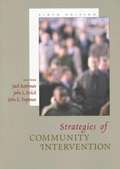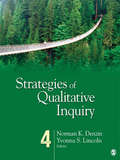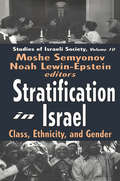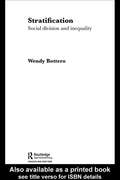- Table View
- List View
Strategies for Asia-Pacific Shipping (Routledge Revivals)
by Richard Gray Jeff HawkinsThis title was first published in 2000. This text focuses on one geographical and economical area - the Asia-Pacific region, on one type of decision makers - commercial shipowners, and on one type of business strategy - corporate level strategy, to show economic change and how organizations manage that change. This book discusses the challenges that shipowners face to take advantage of that growth. It also looks at the lack of information on strategic decision making that could assist the shipowners in taking advantage of the economic situation. The chapters cover the types of business strategies available and how to select the criteria for selecting one of those strategies.
Strategies for Building Multicultural Competence in Mental Health and Educational Settings
by Derald Wing Sue Madonna G. ConstantineThis timely reference also considers building multicultural competence around indigenous healing practices; in clinical supervision contexts; and in culturally sensitive research. Taken together, the book is a much-needed blueprint for making culturally informed decisions, explaining how the multicultural initiatives you implement today can help shape the field's future.
Strategies for Child Welfare Professionals Working with Transgender and Gender Expansive Youth
by Gerald MallonExpert guidance for child welfare and youth care professionals looking to increase their knowledge about, and skills in, working with transgender and gender expansive youth and their families. Many professionals working in child welfare and youth service (including line workers, supervisors, managers, and administrators), lack adequate knowledge about trans or gender expansive identities, which means they are not sufficiently prepared to address or respond to the needs of trans or gender expansive youth. This guide will provide readers with the information they need to do their jobs effectively with youth of all genders, including guidance on relationships, discrimination, mental health, foster care and homelessness. It provides examples of successful practice in a variety of case narratives from youth and their families.
Strategies for Circular Economy and Cross-sectoral Exchanges for Sustainable Building Products: Preventing and Recycling Waste (Springer Tracts in Civil Engineering)
by Cinzia Talamo Marco Migliore Giancarlo PaganinThis book offers a valuable tool for understanding current efforts to promote the reuse and enhancement of pre-consumer waste in the development of new products for the construction sector, as well as the financial and regulatory tools being used to support this trend. It explores the vast and complex topic of the circular economy from the perspective of strategies for the reuse/recycling of waste, and develops a number of key premises: waste reuse/recycling must be considered using a logic of cross-sectoriality, recognizing the need to enhance the “dialogue” between different sectors; pre-consumer waste is particularly interesting for the recycling market because the construction sector can reduce its environmental impacts by enhancing its capacity to use secondary raw materials and by-products from other sectors; and lastly, the manufacturing sector is currently experimenting with promising forms of reducing/recycling pre-consumer waste and is at the same time providing by-products that can be used in other production chains. As such, the book offers a valuable asset for professionals who are interested in sustainability in construction, and in the study of construction products; however, it will be equally useful for local decision-makers tasked with implementing development policies and innovations in the industrial sector.
Strategies for Interpreting Qualitative Data
by Martha S. FeldmanMartha S Feldman's invaluable text outlines four key strategies for interpreting qualitative data: ethnomethodology, semiotics, dramaturgy and deconstruction. The author examines the strengths and weaknesses of each strategy and identifies when to use them. To demonstrate, she applies the techniques of each method to a single data set, highlighting the differences in results.
Strategies for Quantitative Research: Archaeology by Numbers
by Grant S. McCallIt is little secret that most archaeologists are uneasy with statistics. Thankfully, in the modern world, quantitative analysis has been made immensely easier by statistical software packages. Software now does virtually all our statistical calculations, removing a great burden for researchers. At the same time, since most statistical analysis now takes place through the pushing of buttons in software packages, new problems and dangers have emerged. How does one know which statistical test to use? How can one tell if certain data violate the assumptions of a particular statistical analysis? Rather than focusing on the mathematics of calculation, this concise handbook selects appropriate forms of analysis and explains the assumptions that underlie them. It deals with fundamental issues, such as what kinds of data are common in the field of archaeology and what are the goals of various forms of analysis. This accessible textbook lends a refreshing playfulness to an often-humorless subject and will be enjoyed by students and professionals alike.
Strategies for Resisting Sexism in the Academy: Higher Education, Gender and Intersectionality (Palgrave Studies in Gender and Education)
by Gail CrimminsThis book harnesses the expertise of women academics who have constructed innovative approaches to challenging existing sexual disadvantage in the academy. Countering the prevailing postfeminist discourse, the contributors to this volume argue that sexism needs to be named in order to be challenged and resisted. Exploring a complex, intersectional and diverse arrangement of resistance strategies, the contributors outline useful tools to resist, subvert and identify sexist policy and practice that can be deployed by organisations and collectives as well as individuals. The volume analyses pedagogical, curriculum and research approaches as well as case studies which expose, satirise and subvert sexism in the academy: instead, embodied and slow scholarship as political tools of resistance are introduced. A call for action against the propagation of sexism and gender disadvantage in the academy, this important book will appeal to students and scholars of sexism in higher education as well as all those committed to working towards gender e/quality.
Strategies for Scaling Effective Family-Focused Preventive Interventions to Promote Children's Cognitive, Affective, and Behavioral Health: Workshop Summary
by Margie PatlakOver the last three decades, researchers have made remarkable progress in creating and testing family-focused programs aimed at fostering the cognitive, affective, and behavioral health of children. These programs include universal interventions, such as those for expecting or new parents, and workshops for families whose children are entering adolescence, as well as programs targeted to especially challenged parents, such as low-income single teens about to have their first babies, or the parents of children with autism. Some family-focused programs have been shown to foster significantly better outcomes in children, including enhanced educational performance, and reduced rates of teen pregnancy, substance abuse, and child conduct and delinquency, as well as reduced child abuse. The favorable cost-benefit ratios of some of these programs are due, in part, to the multiple and far-ranging effects that family-focused prevention programs targeting children can have. Other family-focused programs have shown success in smaller academic studies but have not been widely applied, or have not worked as effectively or failed when applied to more diverse real-world settings. "Strategies for Scaling Effective Family-Focused Preventive Interventions to Promote Children's Cognitive, Affective, and Behavioral Health" is the summary of a workshop convened by the Institute of Medicine Forum on Promoting Children's Cognitive, Affective, and Behavioral Health to explore effective preventive interventions for youth that can modify risk and promote protective factors that are linked to mental, emotional, and behavioral health, and how to apply this existing knowledge. Based on the 2009 report "Preventing Mental, Emotional, and Behavioral Disorders Among Young People," this report considers how to build a stronger research and practice base around the development and implementation of programs, practices, and policies that foster children's health and well-being across the country, while engaging multi-sectorial stakeholders. While research has advanced understanding of risk, promotive, and protective factors in families that influence the health and well-being of youth, a challenge remains to provide family-focused interventions across child and adolescent development at sufficient scale and reach to significantly reduce the incidence and prevalence of negative cognitive, affective, and behavioral outcomes in children and adolescents nationwide, as well as to develop widespread demand for effective programs by end users. This report explores new and innovative ways to broaden the reach and demand for effective programs and to generate alternative paradigms for strengthening families.
Strategies for Social Inquiry Advances in Comparative-Historical Analysis: Advances in Comparative-Historical Analysis
by James Mahoney Mahoney, James and Thelen, Kathleen Thelen, KathleenAgainst the backdrop of an explosion of interest in new techniques for data collection and theory testing, this volume provides a fresh programmatic statement about comparative-historical analysis. It examines the advances and distinctive contributions that CHA has made to theory generation and the explanation of large-scale outcomes that newer approaches often regard as empirically intractable. An introductory essay locates the sources of CHA's enduring influence in core characteristics that distinguish this approach, such as its attention to process and its commitment to empirically grounded, deep case-based research. Subsequent chapters explore broad research programs inspired by CHA work, new analytic tools for studying temporal processes and institutional dynamics, and recent methodological tools for analyzing sequences and for combining CHA work with other approaches. This volume is essential reading for scholars seeking to learn about the sources of CHA's enduring influence and its contemporary analytical and methodological techniques.
Strategies for Social Inquiry: Case Study Research
by John GerringCase Study Research: Principles and Practices provides a general understanding of the case study method as well as specific tools for its successful implementation. These tools are applicable in a variety of fields including anthropology, business and management, communications, economics, education, medicine, political science, psychology, social work, and sociology. Topics include: a survey of case study approaches; a methodologically tractable definition of 'case study'; strategies for case selection, including random sampling and other algorithmic approaches; quantitative and qualitative modes of case study analysis; and problems of internal and external validity. The second edition of this core textbook is designed to be accessible to readers who are new to the subject and is thoroughly revised and updated, incorporating recent research and numerous up-to-date studies.
Strategies for Survival at SIBIKWA 1988 – 2021: Landmarks of South African Theatre History (Routledge Advances in Theatre & Performance Studies)
by Phyllis Klotz Smal NdabaThis book provides an engaging and contextualised insight into a South African township-based arts centre that has survived the vicissitudes of steady militarisation in townships during some of the worst years of apartheid as well as the exhilaration of a new democratic policy while attempting to circumnavigate different policies and funding dispensations. Sibikwa provides arts centres across the world and especially those in decolonising countries with strategies for survival in tumultuous times. This multi-disciplinary book maps and co-ordinates wider historical, political, and social contextual concerns and events with matters specific to a community-based east of Johannesburg and provides an exploration and analysis by experts of authentic theatre-making and performance, dance, indigenous music, arts in education and NGO governance. It has contemporary significance and raises important questions regarding inclusivity and transformation, the function and future of arts centres, community-based applied arts practices, creativity, and international partnerships. This study will be of great interest to students and scholars in theatre and performance, indigenous music, dance, and South African history.
Strategies for Urban Development in Leipzig, Germany
by Jean-Claude Garcia-ZamorThe demographic pressure caused by migration offers a considerable challenge for urban centers today. It results in an uneven development of the community and focus of urban planners becomes how to provide decent, low-cost housing and transportation in order to facilitate the integration of poorer residents among the rest of the community. In large industrialized countries the challenges of urban policy-makers are made even more complicated since these governments depend on state or federal legislators to obtain the massive amounts of funding required for adequately addressing these local issues that are in global cause. The book analyzes the strategies for urban development in Leipzig, Germany, and shows how civic leaders were able to harmonize planning and equity. They relied heavily on two interesting approaches in that process: the promotion of culture as a key component of urban development and the reconciliation of the inevitable process of gentrification with social equity. The book also looks at the globalization aspect of urban development, reviews research in social equity in urban development in Europe and the United States and describes sustainability as an important element of urban renaissance.
Strategies for Work with Involuntary Clients
by Ronald H. Rooney Rebecca MirickOften in their careers, social workers will encounter clients who are either legally required to attend treatment services or are otherwise coerced or pressured into those services. Practitioners in settings from prisons to emergency rooms to nursing homes to child protection agencies will find themselves with involuntary clients. In an update to this classic text, social workers Ronald H. Rooney and Rebecca G. Mirick explore the best ways to work with unwilling clients.While work with involuntary clients is common, it can be challenging, frustrating, and unproductive unless practitioners are well trained for it. This book provides a theoretical framework for understanding the legal, ethical, and practical concerns when working with involuntary clients, offering theory, treatment models, and specific practice strategies influenced by the best available knowledge. Animated by case studies across diverse settings, these resources can be used by practitioners to facilitate collaborative, effective working relationships with involuntary clients.
Strategies for a Sustainable and Environmentally Friendly Hospital Foodservice Management (Environmental Humanities: Transformation, Governance, Ethics, Law #6)
by Christian BuxSustainable catering aspires to reduce the environmental impacts of foodservice by serving nutritional, safe and environmentally friendly meals, and Italy has embraced the adoption of environmentally friendly diets and the minimization of food waste by introducing the minimum environmental criteria. However, there may be some tension between these two actions as environmentally friendly diets may lead to greater waste. The present book, in the field of the research projects entitled “Monitoring agri-food resilience and environmental savings in Puglia” and “Green supply chain management in the hospital catering service”, has the overarching purpose to improve the understanding of environmental, economic and social sustainability of foodservice, by considering the significant variables of energy efficiency, environmental impacts, waste management, customer satisfaction and user nutrition. The book reports the findings of different studies conducted in the hospital foodservice.
Strategies of Community Intervention (6th edition)
by Jack Rothman John L. Erlich John E. TropmanThis volume takes a broad view of community organization, viewing it as a rich and diverse field of practice that includes policy analysis and development, program planning, administration, evaluation, and resource development and allocation. The Sixth Edition emphasizes strategic and tactical considerations in community change. It treats social planning and policy initiatives, neighborhood-based citizen and empowerment approaches, and advocacy-oriented social action.
Strategies of Qualitative Inquiry
by Norman K. Denzin Yvonna S. LincolnThis book is the second of three paperback volumes taken from The SAGE Handbook of Qualitative Research, Fourth Edition. This volume isolates the major strategies—historically, the research methods—that researchers can use in conducting concrete qualitative studies. The question of methods begins with questions of design and the matters of money and funding. These questions always begin with the researcher who moves from a research question to a paradigm or perspective, and then to the empirical world. The history and uses of these strategies are explored extensively in this volume. The chapters move from forms (and problems with) mixed methods inquiry to case study, performance and narrative ethnography, to constructionist analytics to grounded theory strategies, testimonies, participatory action research, and clinical research.
Strategies of Sex and Survival in Female Hamadryas Baboons: Through a Female Lens
by Larissa SwedellThis book describes the first field study focusing on the behavior of hamadryas females in the wild. In its attempt to rectify the male-biased view of hamadryas baboon behavior that has persisted over the decades, this book suggests that female behavior contributes more to hamadryas social organization than has previously been assumed and that females may, in fact, be acting in their own best interests after all. For upper-level undergraduate courses on primate behavior and ecology.
Strategische Onlinekommunikation
by Olaf Hoffjann Thomas PleilOnlinekommunikation und speziel Social Media sind als besonders wichtige Herausforderungen des Kommunikationsmanagements erkannt. Kaum ein Unternehmen verzichtet mittlerweile auf die Beobachtung von Diskussionen im Internet und die Umsetzung eigener Kommunikationsstrategien im Social Web. Dort verändern sich für die PR und die Organisationskommunikation zentrale Aspekte: Öffentlichkeiten können heute sehr viel schneller entstehen. Es sind neue Formen der Meinungsbildung zu beobachten, die zunehmend weniger den Mechanismen der Massenkommunikation folgen, sondern Ergebnis netzwerkartiger Prozesse sind. In diesem Umfeld entstehen gleichzeitig neue Formen der Beteiligung, die durch entsprechende niederschwellige Instrumente im Internet erst ermöglicht werden. Aus Organisationssicht verändern sich damit unter anderem Entstehung und Pflege von Reputation oder das Management von Stakeholderbeziehungen. Zehn Jahre nach Beginn der Fachdiskussion zu PR und sozialen Medien gibt dieser Band auf Basis aktueller Untersuchungen Einblick in die Praxis und in aktuelle Herausforderungen der Organisationskommunikation im Internet.
Strategische Wahrheiten: Desinformation und Postfakten in der strategischen Kommunikation
by Olaf Hoffjann Lucas Seeber Ina von der WenseStrategische Kommunikation zielt mit ihren kontingenten Wirklichkeitsbeschreibungen seit jeher auf gesellschaftliche Wahrheitsmodelle. Wie häufig gesellschaftliche Wahrheitsmodelle auf strategische Kommunikationsbemühungen zurückgehen, auf Unwahrhaftigkeit beruhen und damit zumindest zeitweise zu strategischen Wahrheiten werden, zeigen eindrucksvoll zwischenzeitlich geglaubte Wahrheiten, die sich als Lüge entpuppt haben: von Walter Ulbrichts „Niemand hat die Absicht, eine Mauer zu errichten“ über Hitlers Tagebücher bis hin zu den Massenvernichtungswaffen im Irak. Die erfolgreichen Kampagnen der Brexiteers und von Donald Trump 2016 haben diesem Thema zu neuer und bislang ungeahnter Aufmerksamkeit verholfen. Während die Themen Desinformation und postfaktische Gesellschaft die Journalismus-, politische Kommunikations- und Medienethikforschung aktuell zu dominieren scheinen, ist das Schweigen der deutschsprachigen und internationalen PR- und Organisationskommunikationsforschung auffällig. Dies ist umso bemerkenswerter, weil die PR-Wissenschaft in der Vergangenheit immer wieder versucht hat, ihren Gegenstand zu schärfen, indem sie sich am Begriff der Propaganda abgearbeitet hat. Daraus müsste eigentlich eine Affinität für das Thema Desinformation resultieren. Aber genau das Gegenteil ist offensichtlich der Fall: Hat sich die PR-Wissenschaft gerade deshalb nicht mit Desinformation beschäftigt, weil sie sich so dezidiert von Propaganda und darin eingeschlossenen desinformierenden und manipulativen Techniken abgrenzen will? Was sind die Gründe hierfür? Glauben wir, bereits alles zum Thema gesagt zu haben? Liegt dies daran, dass sich die PR- und Organisationskommunikationsforschung seit jeher vor allem für Unternehmen und weniger für politische und Non-Profit-Organisationen interessiert? Oder fühlen wir uns hier schlicht und ergreifend nicht zuständig? Es scheint offenkundig höchste Zeit zu sein, sich wieder eingehend mit Fragen der Desinformation aus der Perspektive der strategischen Kommunikationsforschung zu befassen. Die Beiträge des Tagungsbandes fokussieren hierzu auf neue theoretische Perspektiven, normative Bewertungen und empirische Befunde.
Strategisches Framing: Eine Einführung
by Michael OswaldIn der Politischen Kommunikation sind Frames allgegenwärtig, da die politische Realität oft spezifisch konstruiert wird. Kommunikatoren setzen dabei ihre Information in einen bestimmten Deutungsrahmen, um gewisse Stimmungen zu verbreiten. Sie ‚framen‘ damit das Thema gezielt und wollen so die Debatte um die jeweilige Angelegenheit leiten oder zumindest mitbestimmen. Dieses Lehrbuch bietet eine Einführung in das Verständnis von Frames und Framing-Strategien, es liefert eine Übersicht der Inhalte der vielfältigen und breitgefächerten Framing-Forschung sowie eine Grundlage für das wissenschaftliche Arbeiten mit Frames.
Strategisches Framing: Eine Einführung
by Michael OswaldIn der Politischen Kommunikation sind Framings allgegenwärtig. Zum einen entstehen sie unwillkürlich, da Themen stets in einer spezifischen Perspektive dargestellt werden. Zum anderen wird die politische Realität auch oft konstruiert. Kommunikatoren setzen dabei ihre Information in einen bestimmten Deutungsrahmen, sie ‚framen‘ das Thema also gezielt und wollen so die Debatte um die jeweilige Angelegenheit leiten oder zumindest mitbestimmen. Dieses Lehrbuch bietet eine Einführung in das Verständnis von Frames und Framing-Strategien. Es liefert einen Abriss über die vielfältige und breitgefächerte Framing-Forschung sowie eine Grundlage für das wissenschaftliche Arbeiten mit Frames. Für die 2. Auflage wurde das Buch grundlegend überarbeitet und aktualisiert.
Strategizing against Sweatshops: The Global Economy, Student Activism, and Worker Empowerment
by Matthew S. WilliamsFor the past few decades, the U.S. anti-sweatshop movement was bolstered by actions from American college students. United Students Against Sweatshops (USAS) effectively advanced the cause of workers’ rights in sweatshops around the world. Strategizing against Sweatshops chronicles the evolution of student activism and presents an innovative model of how college campuses are a critical site for the advancement of global social justice. Matthew Williams shows how USAS targeted apparel companies outsourcing production to sweatshop factories with weak or non-existent unions. USAS did so by developing a campaign that would support workers organizing by leveraging their college’s partnerships with global apparel firms like Nike and Adidas to abide by pro-labor codes of conduct. Strategizing against Sweatshops exemplifies how organizations and actors cooperate across a movement to formulate a coherent strategy responsive to the conditions in their social environment. Williams also provides a model of political opportunity structure to show how social context shapes the chances of a movement’s success—and how movements can change that political opportunity structure in turn. Ultimately, he shows why progressive student activism remains important.
Strathclyde and the Anglo-Saxons in the Viking Age: And The Anglo-saxons In The Viking Age
by Tim ClarksonThe acclaimed medievalist examines the rise and fall of the last kingdom of the North Britons and their influence on the Anglo-Saxons. During the Viking period, the Kingdom of Strathclyde stretched across what is now southern Scotland and northern England. Also known as Cumbria, its kings ruled from Govan on the outskirts of present-day Glasgow. Shining a spotlight on these North Britons, or &“Cumbrians,&” this volume chronicles their relations with Anglo-Saxon England from the ninth to eleventh centuries AD. In the tenth century, Strathclyde extended its rule southward from Clydesdale to the Solway Firth, bringing their language and culture to a region that had been in English hands for more than two hundred years. They played a key role in the political events of the time, from leading their armies in battle to forging treaties and preserve a fragile peace. The extensive Cumbrian realm was eventually conquered by the Scots, but is still memorialized today by the English county of Cumbria. How this county acquired the name of a long-vanished kingdom centered on the River Clyde is one of the mysteries explored in this book. The story of Strathclyde and the Anglo-Saxons is an important chapter in the saga of England and Scotland as they emerged from the Dark Ages as the countries we know today.
Stratification in Israel: Class, Ethnicity, and Gender (Schnitzer Studies In Israel Society Ser. #Vol. 10)
by Moshe SemyonovUntil recently, issues surrounding ethnic-linked inequality, whether between Jews and Arabs or between Jewish ethnic groups, have dominated research on stratification in Israel to the exclusion of other dimensions. Rapidly growing inequality in Israeli society, and its intergenerational persistence, however, have generated several new trends in research. The chapters included in this volume represent the range and depth of recent developments in the study of social stratification, mobility, and inequality. Although they address a variety of issues, they have in common a focus on the institutional mechanisms that govern the allocation of rewards.
Stratification: Social Division and Inequality
by Wendy BotteroOffering a fresh and exciting new perspective on differentiation and inequality, this absorbing book investigates how our most personal choices (of sexual partners, friends, consumption items and lifestyle) are influenced by hierarchy and social difference. Exploring the topics of assortative mating; social capital; friendship networks and cultural identity; the book examines how hierarchy affects our tastes and leisure time activities, and who we choose (and hang on to) as our friends and partners. This book: * introduces debates on stratification by exploring its effect on everyday social relations* relates class inequalities to broader processes of social division and cultural differentiation, exploring the associational and cultural aspects of hierarchy* explores how groups draw on social, economic and cultural resources, using cultural 'cues', to admit some and exclude others from their social circle* explores new theoretical approaches to stratification: drawing on cultural theories of class, social interaction approaches, and research on differential association The book has a novel and fresh new way of looking at a well-established area in sociology - social stratification.























